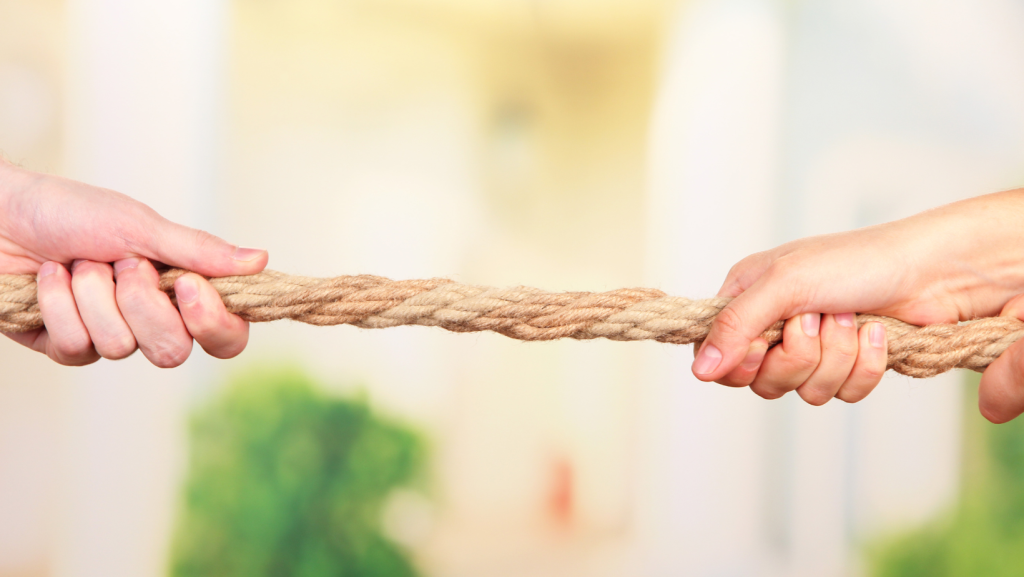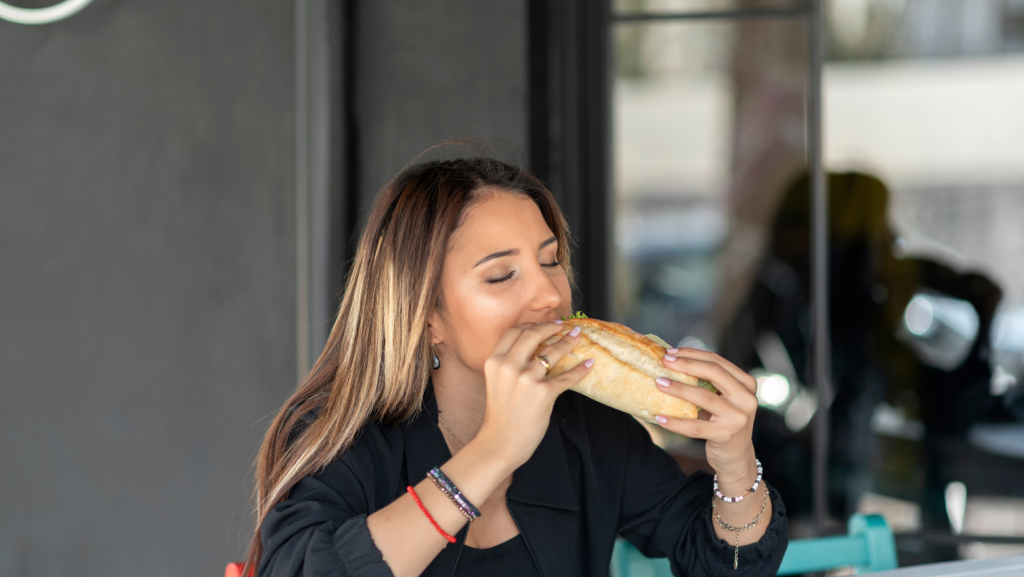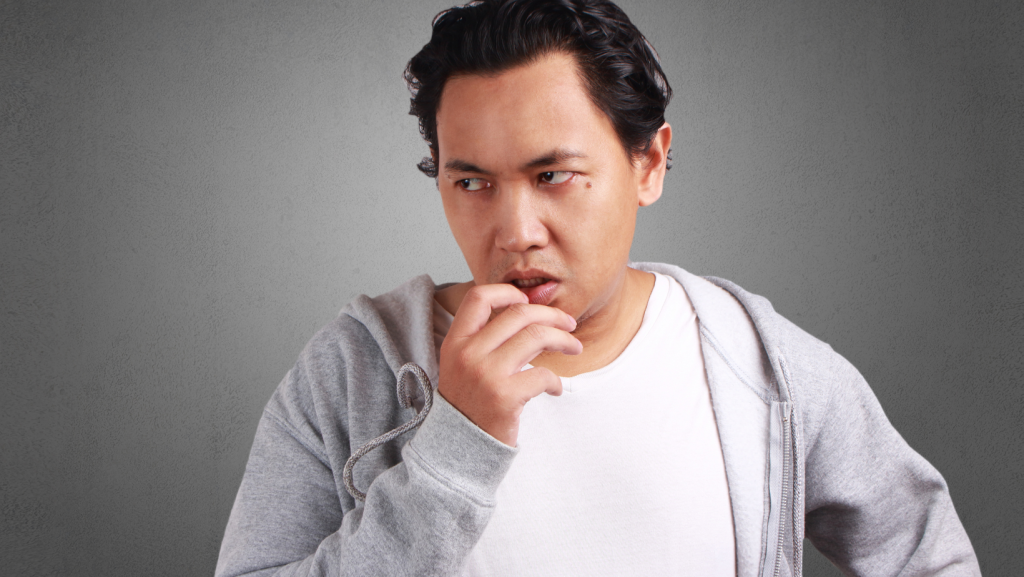The awareness of – and struggle over – what can be both gained and lost is at the heart of this growth. It requires stretching, accepting, even grieving.
An eating disorder can develop for many reasons. At its core is a yearning to cope with emotions and situations…in other words, with life. And yet, this coping mechanism is really an entry into a downward spiral of more problems. And those problems can lead to ambivalence in eating disorder recovery, as there becomes conflict between holding on and letting go.
You want to recover. You want to be healthy. But you don’t want to forfeit your access to a convenient mechanism for dealing with life’s struggles.

And guess what? This ambivalence is normal. In fact, it’s an expected part of the disorder and of recovery in particular. (Hello, tug-of-war.)
Regardless of the presence of an eating disorder, every day presents constant choices that are inevitably imbued with opportunities for ambivalence. You want what you want how you want it, and that scenario isn’t always feasible. That’s the essence of choosing.
As a matter of fact, the process of facing difficult, life-changing decisions is how a person matures emotionally, socially, and intellectually.
And it often involves extraordinary change.
While not all eating disorders are the same, ambivalence in eating disorder recovery is one of the overlapping characteristics across disorders and their sufferers. If you follow this blog, you know the variety and complexities of eating disorders. There are many types.
In a word, eating disorders are individual.
Ambivalence in Eating Disorder Recovery
Part of you wants recovery, part of you doesn’t.
Becoming well involves work (ugh).
But remaining unwell is depleting your life. (Another form of “work.”)
You’re sick of all the doctor’s appointments and bloodwork.
Where do I want to be in 1 year?
But you’re also sick and tired of being sick and tired.
Add in the glaring truth that you don’t want to be like everyone else. The eating disorder has become part of your identity. What would you do – what would you be – without it?
And so the internal struggle goes.
Having mixed feelings about recovery is to be expected.

One reason has to do with Diet Culture.
Another has to do with the tendency for sufferers not to recognize just how sick they are. (Kind of like fish not knowing they’re wet.)
The danger of ambivalence, while normal, is that it can keep you stuck.
The upside of ambivalence, while normal, is that it can keep you stuck.
And the fluctuation between the drive to recover and the resistance to that commitment can happen at any point in recovery.
The inevitable result is treatment delays, relapses, or quitting.
Fortunately, there are ways to effectively work through this to-be-expected phase of recovery.
Strategies to Address Ambivalence in Eating Disorder Recovery
Feelings vs. facts

You can be in recovery, engaging in recovery behaviors, even if your mind is not completely on board.
Feeling scared or anxious about recovering doesn’t mean you’re better off avoiding recovery. Feelings are just feelings. They come, and they go.
Put another way: Recovery requires that you take your feelings out of the driver’s seat.
Let’s say you’re considering having a tuna sandwich for lunch. You want to eat it because you know you “should.” It will, after all, be nourishing – a good thing.
But an interrupting voice in your head is telling you not to eat it. You had promised yourself you wouldn’t eat until a certain time of day.
Just because part of you doesn’t want to eat it, you aren’t mandated to listen to or abide by the directives you created.
Instead, you can override that voice and choose the recovery oriented-decision. Eat the sandwich! Put on mayo and have a pickle, too (without factoring in what you ate earlier or what you anticipate eating later).
Acting as-if
Opposition to recovery and a simultaneous desire for it is a difficult internal conflict to sit with.
One way to proceed is to take this cognitive dissonance as an opportunity to act as if you want recovery.
In a particular moment, what would the recovery-oriented choice be? Whatever that is, do that, even if it’s associated with anxiety or fear.
As someone used to doing hard things, do the hard thing: Act as if you’re on board with recovery.
Let’s say, for example, that you could go to your room and binge to deal with intense emotions, or you could go for a walk. Consider acting as if you prefer to go for a walk.

Values alignment
Make decisions that are in accordance with your values.
If you value kindness, well-being, and fairness, then a recovery-oriented decision would be more aligned than a decision to engage in eating disorder symptoms.
Given the option of going to the movies with your friends or staying home and engaging in symptoms, choose the movies. (Unless, of course, you value pain, harm, and danger. In that case, stay home.)
A values-aligned decision of going to the movies is more consistent with what you stand for – friendship, connection, and sharing good times with loved ones.
What you do reflects who you are. Itss your integrity. How do you want to be known? How do you want to live your life?

There are so many benefits to a values-aligned lifestyle.
People with an eating disorder often say they don’t want an eating disorder for their whole lives.
And yet, they don’t identify the age after which they don’t want to have an eating disorder.
There is no better time than RIGHT NOW to start on the recovery path. The longer you stay immersed in eating disorder symptoms, the harder they will be to conquer.
At some point, you have to draw a line in the sand and choose action over ambivalence in eating disorder recovery.
It’s common to justify engaging in eating disorder symptoms when you tell yourself something like, “Starting Monday, I’ll ‘be good.’ This is the last time I’m going to do this behavior (restrict/binge/purge), so it’s ok.”
Choose your rationalization: a constantly protracted starting date, a symptom-indulging resignation (“I might as well get binging over with. Once I start studying for the exam I’m going to binge anyway. Let’s just get it out of the way.”), whatever. The outcome will be the same.
Do you want to be engaging in these same behaviors for the rest of your life? For 10 years? 5 years? 1 year?
You might as well start working on recovery now.
That doesn’t mean you’ll never eat certain foods. It just means you may do so with more self-awareness and attunement to your hunger and fullness.
Practice makes progress.
There are many other options, such as DBT “opposite action.” As the name implies, you engage in the behavior that is literally the opposite of what you are inclined to do.
So, instead of restricting, you eat. Instead of purging, you do something else – something (non-disordered) that is pleasant and rewarding.

Another option is to create a list of 20 self-care strategies. Keep the list handy and read it often.
Decide on a plan to do “x” number of the activities daily or on alternating days for a week, two weeks, a month…however long you decide. Monitor and write down what you do each week.
These techniques, when practiced, will strengthen your recovery process and eventually become default.

Feeling hesitant about fully committing to recovery is normal. Just thinking about change can be daunting. It’s human nature to prefer to stay in a comfort zone.
But how comfortable is that zone when you’re sick?
By accepting ambivalence in eating disorder recovery as a normal part of the process, you’ll be able to work through it.

There is no maybe about that.
Dr. Elayne Daniels is an international coach, consultant, and psychologist specializing in eating disorders, body image, and High Sensitivity. She is anti-diet, Intuitive Eating certified and passionately believes comfort in your body at any size is your birthright. Contact her here for more information.
To read more about body image, check out some blog articles.
And, if you’re struggling with overcoming an eating disorder, this e-book might be useful.
